Why a Clogged Bathroom Sink Needs Quick Action
A clogged bathroom sink is one of the most frustrating plumbing problems homeowners face. You turn on the faucet and watch water pool in the basin, draining slower than molasses. Sometimes you hear gurgling sounds. Other times the water just sits there, refusing to budge.
Quick Solutions for a Clogged Bathroom Sink:
- Pour boiling water down the drain to dissolve soap scum
- Use baking soda and vinegar - natural fizzing action breaks up clogs
- Remove the stopper and clean accumulated hair and gunk
- Check the P-trap underneath - often where major clogs hide
- Try a plastic drain tool to pull out hair clumps
The good news? Nine out of ten bathroom sink clogs are caused by hair, according to plumbing experts. This means most blockages happen in easy-to-reach spots that you can fix yourself.
Hair combines with soap scum, toothpaste, and other grooming products to create a nearly impenetrable mess. But with the right approach, you can tackle most clogs without calling a plumber.
Don't let a slow drain turn into a complete blockage. The sooner you act, the easier the fix becomes.
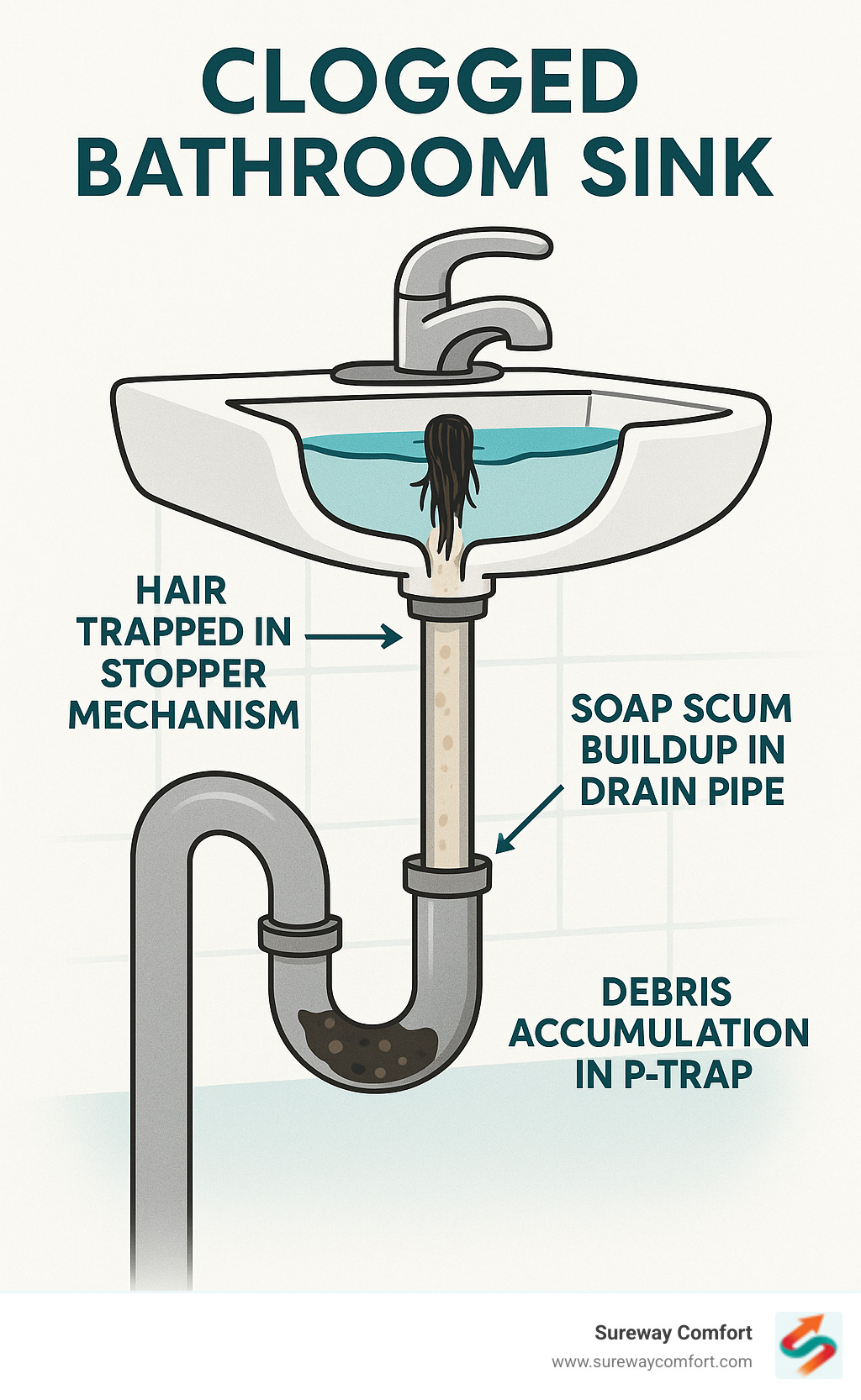
Related content about clogged bathroom sink:
What Causes a Bathroom Sink to Clog?
Let's get to the bottom of what's actually creating that frustrating clogged bathroom sink situation. Understanding the villains behind the blockage helps you tackle the problem more effectively.
Hair is the number one culprit – and it's probably no surprise. Every time you brush your teeth, wash your face, or style your hair, loose strands slip down the drain. Long hair is especially sneaky, wrapping around the stopper mechanism like it's trying to build a nest down there.
But here's the thing: hair rarely works alone. It teams up with other bathroom products to create the perfect storm of gunk.
Soap scum acts like the glue that holds everything together. When soap mixes with the minerals in your water, it creates a sticky film that coats your pipes. This film gives hair something to grab onto, turning a few loose strands into a solid blockage.
Toothpaste might seem harmless, but it adds to the sticky mess, especially when you're rushing through your morning routine and don't rinse thoroughly. Those minty globs can harden and catch other debris floating by.
Grooming products like lotions, shaving cream, and styling gels contribute their own special brand of stickiness. Thick lotions are particularly troublesome – they're designed not to wash off easily, which means they don't go down your drain easily either.
Sometimes small objects join the party uninvited. Cotton swabs, dental floss, bottle caps, or jewelry can slip down the drain and act like a dam, catching everything else that follows.
This gradual buildup happens slowly over weeks and months. What starts as slightly slower drainage eventually becomes standing water that won't budge. Most of this mess collects in easy-to-reach spots like around the stopper or in the P-trap under your sink.
The good news? Since you know what causes the problem, you can target your cleaning efforts exactly where they'll do the most good.
How to Unclog Your Bathroom Sink: A Step-by-Step Guide
Ready to tackle that clogged bathroom sink? Let's roll up our sleeves and get your drain flowing freely again. I'll walk you through each method, starting with the gentlest approaches first. Trust me, most clogs are easier to fix than you think!
Step 1: Start with Simple, Natural Solutions
Before reaching for harsh chemicals or calling a plumber, let's try some surprisingly effective household remedies. These natural methods are gentle on your pipes and often work wonders on minor clogs.
Boiling water is your first weapon of choice. It's amazing how often this simple solution melts away soap scum and dissolves greasy buildup. Just boil a large pot of water and pour it down the drain in two or three stages, letting each pour work for a few seconds.
Important note: If you have PVC pipes or a delicate porcelain sink, use very hot tap water instead of boiling water to avoid damage.
The classic baking soda and vinegar combo creates a powerful fizzing reaction that breaks down organic matter. Pour about 1/3 cup of baking soda down the drain, followed by 1/3 cup of white vinegar. You'll hear it start bubbling immediately!
Cover the drain with a stopper or wet rag to keep the reaction contained. Let this cost-friendly interaction work its magic for at least an hour - overnight is even better for stubborn clogs. Then flush with hot water.
For extra stubborn buildup, try mixing baking soda with salt. Combine 1/2 cup of each and pour the mixture down your drain. Wait 15 minutes, then follow with boiling water. The salt adds gentle abrasive action while the baking soda works to break down grime.
These natural methods first approach protects your pipe safety while being kind to the environment. You'd be surprised how often they completely solve the problem!
Step 2: Use a Tool to Clear a clogged bathroom sink
When natural solutions need backup, it's time to get physical with the clog. These tools are incredibly effective at grabbing and removing the hair clumps that cause most bathroom sink blockages.

A plastic drain clearing tool (often called a "Zip-It") is absolutely magical for hair clogs. This simple plastic strip has tiny barbs that grab onto hair like Velcro. Remove your sink stopper first, then slide the tool down as far as it goes. Twist it gently as you pull it back up - you'll be amazed at the gross tangle of hair it retrieves!
Don't have a specialized tool? A wire hanger works in a pinch. Straighten it out and bend one end into a small hook. Fish around gently in the drain to snag hair clumps, but be careful not to push the clog deeper.
Your trusty plunger can also work wonders on sink clogs. Make sure you have about an inch of water covering the rubber cup, then pump vigorously while maintaining a tight seal. The suction often dislodges stubborn blockages.
Always wear gloves when doing this work - trust me on this one! Keep a bucket nearby to catch any gunk you pull out.
Essential tools for simple clogs: plastic drain clearing tool, sink plunger, rubber gloves, bucket for debris, and old towels for cleanup.
Step 3: Clean the Sink Stopper and Pivot Rod
Here's where many people find the real culprit behind their clogged bathroom sink - it's not always deep in the pipes! Your pop-up stopper mechanism is often a hair and grime magnet.
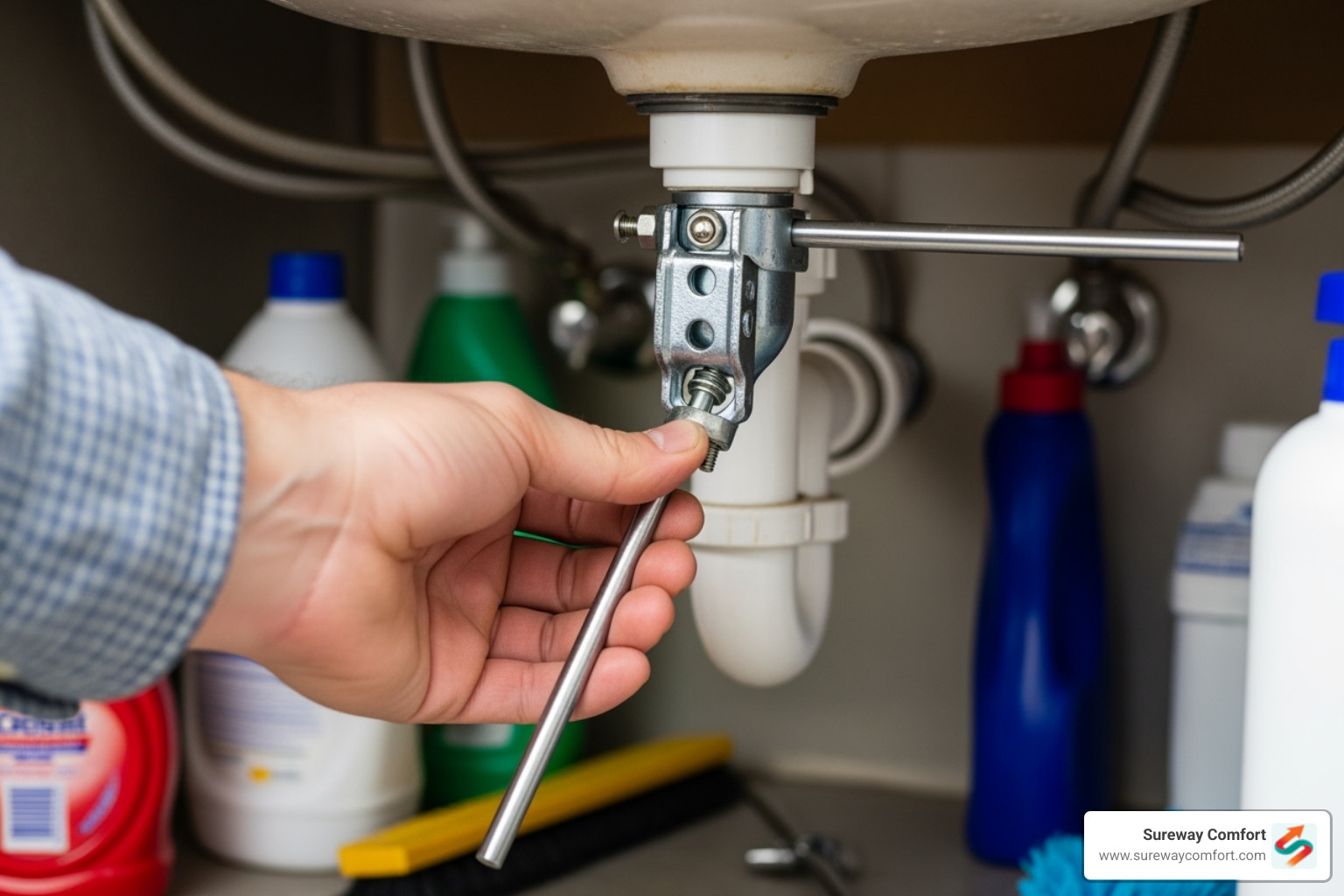
The pop-up stopper connects to a pivot rod underneath your sink, which threads through something called a clevis strap. This whole mechanism becomes a collection point for hair and soap scum.
Start by placing a bucket under the sink to catch drips. Look for the horizontal pivot rod that extends from your drain pipe - there's usually a nut holding it in place. Unscrew this nut (you might need pliers) and gently pull the rod straight out.
Now you can lift the pop-up stopper right out from the top of your sink. Prepare yourself - the amount of disgusting gunk wrapped around these parts might shock you!
Use an old toothbrush to scrub away all the accumulated hair and soap scum from both the stopper and the pivot rod. Clean the drain opening thoroughly too. This step alone often completely solves drainage problems.
Reassemble everything by dropping the clean stopper back in, reinserting the pivot rod (make sure it goes through the hole in the stopper), and tightening the nut. Test that your stopper moves up and down smoothly.
If you're having trouble with this process, this guide on releasing the stopper provides additional helpful details.
Step 4: Clean the P-Trap for Stubborn Clogs
When your clogged bathroom sink refuses to cooperate after trying everything else, the problem is likely hiding in the P-trap. This U-shaped pipe under your sink traps water to prevent sewer gases from entering your home, but it also traps hair, soap scum, and other debris.
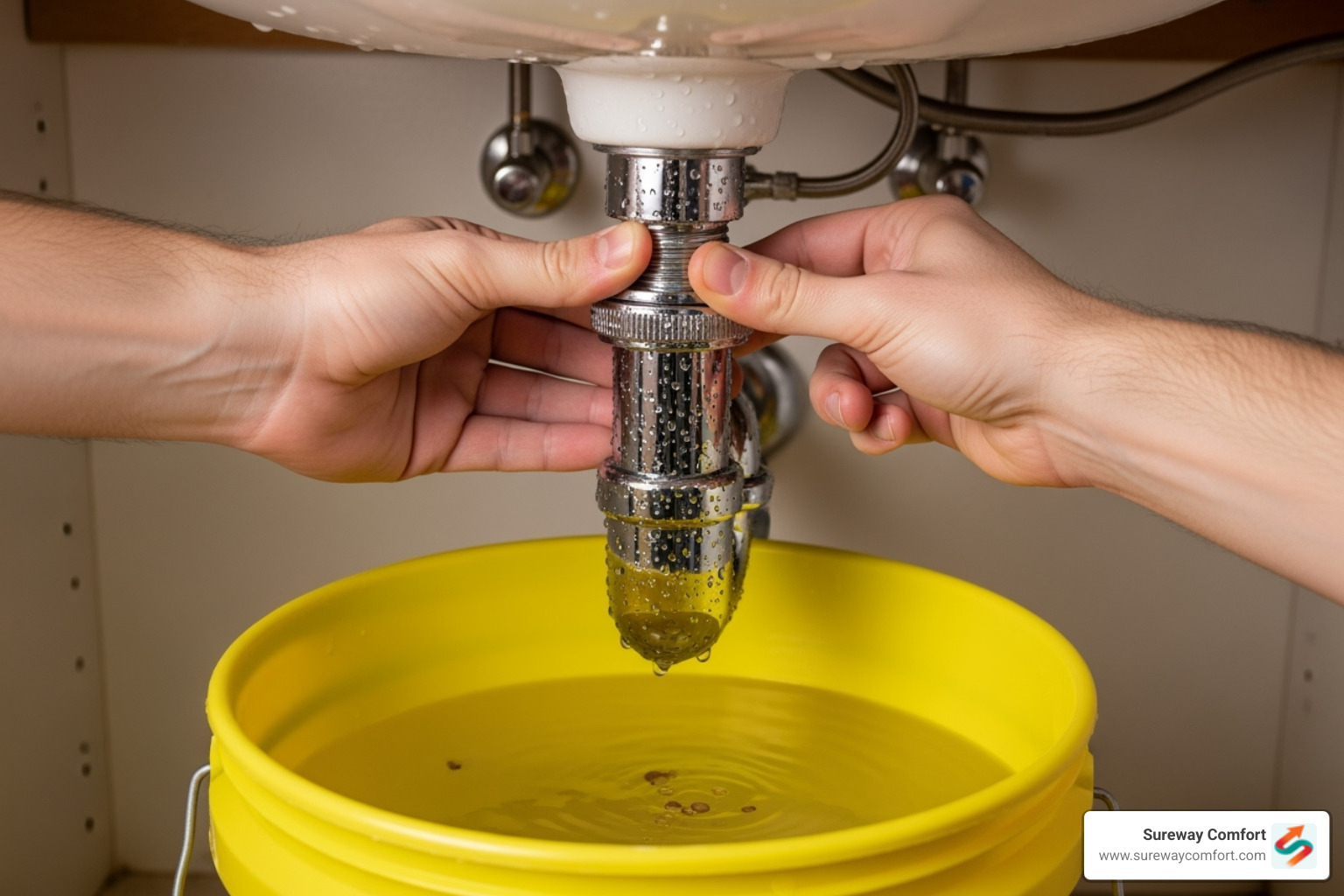
This job requires a bit more effort, but it's incredibly effective for persistent clogs. Clear out your under-sink cabinet and place a large bucket directly under the P-trap - things are about to get messy!
The P-trap connects with two large slip nuts that you can usually loosen by hand or with pliers. As you remove the curved section, expect water and accumulated gunk to pour into your bucket. The smell might be... memorable.
Take the removed P-trap to another sink or outside for thorough pipe cleaning. Use a bottle brush, wire, or old toothbrush to scrub out every bit of hair and buildup. Clean the connecting pipes too while you're at it.
When reassembling, hand-tighten the slip nuts first, then snug them with pliers - but don't overtighten! Plastic fittings can crack if you're too aggressive.
Run water and carefully check for leaks around your connections. A small adjustment usually stops any drips. This thorough checking for leaks step prevents water damage later.
Cleaning the P-trap might seem intimidating, but it's often the permanent solution your stubborn drain needs!
Preventing Future Bathroom Sink Clogs
Now that you've conquered your clogged bathroom sink, let's make sure you never have to deal with that frustration again. Think of it like brushing your teeth – a few simple daily habits can prevent much bigger problems down the road.
The game-changer? A drain strainer or hair catcher. This simple mesh screen sits over your drain opening and catches hair before it can start its journey into your pipes. It's honestly the best investment you can make for about five dollars. Just remember to clean it out regularly – ideally after every use, but at least daily. Simply lift it out, dump the hair in the trash, and you're done.
Make friends with your sink stopper. Since we know how much gunk loves to collect around that pivot rod, why not stay ahead of it? Pop that stopper out every few weeks and give it a quick scrub with an old toothbrush. It takes two minutes and prevents the nasty buildup that leads to major clogs.
Be mindful about what goes down the drain. Your bathroom sink isn't a garbage disposal. Those thick face creams, hair masks, and glob of toothpaste might seem harmless, but they're building up in your pipes. Wipe off excess products with a tissue before rinsing your hands or face.
Hot water is your friend. Once a week, run hot water down your drain for about 15 seconds. This simple flush helps melt away soap scum before it hardens and becomes a problem. Think of it as a mini spa treatment for your pipes.
Monthly maintenance keeps things flowing smoothly. Even when everything seems fine, treat your drain to a monthly baking soda and vinegar treatment. Pour half a cup of baking soda down the drain, follow with half a cup of white vinegar, wait 30 minutes, then flush with hot water. It's like a gentle reset button for your plumbing.
Keep grease out of the equation. While it's more common in kitchen sinks, sometimes we rinse greasy hands or makeup brushes in the bathroom. Grease solidifies in cold pipes and creates sticky traps for hair and debris. A quick wipe with a paper towel before rinsing saves you headaches later.
These simple habits become second nature quickly, and trust me – your future self will thank you when you never have to fish disgusting hair clumps out of your drain again.
When DIY Isn't Enough: Time to Call a Professional
Sometimes you've tried everything – boiling water, baking soda and vinegar, that trusty plastic drain tool, even dismantling the P-trap – and your clogged bathroom sink is still giving you grief. Don't worry, you're not a failure at home maintenance! There are simply times when the problem runs deeper than what DIY methods can reach.
Multiple clogged drains are your first red flag that something bigger is going on. When it's not just your bathroom sink but also your shower, toilet, or kitchen sink acting up, you're likely dealing with a main sewer line issue. All your home's drains eventually connect to one main line, and when that gets blocked, everything backs up like a traffic jam.
Recurring clogs are another telltale sign. You clear the drain, it works great for a week or two, then boom – slow drainage again. This frustrating cycle usually means there's a stubborn blockage further down the line that your home remedies just can't reach.
Pay attention to foul odors wafting up from your drains. That sewage-like smell isn't just unpleasant – it's your plumbing system crying for help. These odors often indicate a blockage that's allowing sewer gases to back up into your home.
Here's something that might surprise you: if flushing your toilet makes your bathroom sink gurgle, or vice versa, that's not normal! These gurgling noises from other drains suggest problems with your main drain or vent system that require professional attention.
The US Environment Protection Agency reports that almost one trillion gallons of water is wasted every single year due to household leaks and plumbing issues. A constantly slow drain or recurring clogged bathroom sink contributes to this massive water waste – not to mention the frustration and potential damage to your home.
Chemical drain cleaners might seem like a quick fix, but they often create more problems than they solve. These harsh chemicals can damage your pipes, especially if you have older plumbing, and they're terrible for the environment. If you've used them and suspect pipe damage, it's definitely time for professional help.
Watch for outdoor warning signs too. Wet spots in your yard, especially near where your sewer line runs, or unexplained indentations in your lawn can indicate underground pipe problems. Tree roots love to seek out moisture and can invade pipes, creating major blockages that require specialized equipment to clear.
When your DIY efforts aren't cutting it, our experienced technicians at Sureway Comfort are ready to step in. We serve Bridgeville, PA, and the surrounding areas including South Fayette, Upper St. Clair, Mt. Lebanon, McDonald, Scott Township, Canonsburg, and Bethel Park. We have the professional-grade tools and expertise to diagnose and fix even the most stubborn drain issues, getting your plumbing back to working order safely and efficiently.
Frequently Asked Questions about a clogged bathroom sink
When you're dealing with a clogged bathroom sink, you probably have questions. We hear these same concerns from homeowners throughout the Canonsburg area almost daily. Let's tackle the big ones that keep coming up.
Are chemical drain cleaners safe to use on my pipes?
Here's the honest truth: we strongly recommend avoiding chemical drain cleaners whenever possible.
Most store-bought drain cleaners contain sodium hydroxide (lye) or sulfuric acid - chemicals that are designed to burn through organic matter like hair and soap scum. While that sounds like exactly what you need for a clogged bathroom sink, these harsh chemicals create more problems than they solve.
The heat generated by these cleaners can warp plastic pipes and corrode metal ones, especially if you have older plumbing. We've seen homeowners create expensive pipe damage trying to save money on a simple clog. Even worse, if the chemical doesn't fully clear the blockage, it leaves your pipes filled with dangerous, corrosive liquid that makes it hazardous for any plumber to work on your drain.
There's also a practical problem: chemical cleaners often don't work as advertised. If you have standing water in your sink, the cleaner gets diluted and loses its effectiveness. Sometimes the chemical reaction just turns your hair clog into a gooey, harder-to-remove mess further down the pipe.
Safety is another major concern. These products can cause severe burns to your skin and eyes, and the fumes are harmful to breathe. The chemical reaction in your drain can sometimes cause dangerous blowback.
The natural solutions and mechanical tools we covered earlier are safer, more effective, and won't damage your plumbing. Your pipes (and your wallet) will thank you for trying the baking soda and vinegar method or a plastic drain tool first.
How often should I clean my bathroom sink drain to prevent clogs?
Prevention is so much easier than dealing with a full blockage. We recommend a simple routine that takes just minutes but saves hours of frustration later.
Daily maintenance is the easiest step: if you're using a drain strainer or hair catcher, just lift it out and toss the caught hair in the trash. This one habit alone prevents most bathroom sink clogs from ever forming.
Once a week, run hot water down your drain for about 15 seconds after your shower or when you've done a lot of grooming. This helps flush away soap residue before it can build up and create that sticky surface that traps hair.
Monthly deep cleaning is where you'll see the biggest impact. Mix half a cup of baking soda with half a cup of white vinegar, pour it down the drain, let it sit for 30 minutes, then flush with hot water. This natural cleaning keeps minor buildup from becoming major problems.
Also once a month, remove and clean your pop-up stopper if you have one. This is where an shocking amount of gunk accumulates, and cleaning it regularly prevents that buildup from becoming a stubborn clog.
Every few months, take a peek at your P-trap area under the sink. If you notice your drain starting to slow down even slightly, cleaning the P-trap right away can prevent a complete blockage.
Think of it like brushing your teeth - a little regular maintenance prevents much bigger problems down the road.
What is a P-trap and why does it get clogged?
The P-trap is that curved, U-shaped pipe directly under your bathroom sink. You've probably seen it when storing cleaning supplies in your vanity cabinet. It might look like just another piece of plumbing, but it's actually doing some important work.
Its main job is keeping sewer gases out of your home. The P-trap holds a small amount of water at all times, creating a seal that prevents those unpleasant smells from rising up through your drain. Without it, your bathroom would smell like a sewer.
But here's where the clog problem comes in: that same curved design that traps gases also creates the perfect collection point for everything that goes down your drain. Hair gets snagged on the rough interior surfaces of the curved pipe. Soap scum coats the inside, creating a sticky surface that grabs onto more hair and debris. Toothpaste and grooming products add to the gooey buildup.
Any small objects that accidentally fall down the drain - like jewelry, cotton swabs, or dental floss - almost always end up caught in the P-trap, where they act like anchors for more debris to collect.
Over time, all this accumulated material fills up the space that's supposed to hold just water, blocking the flow and creating a clogged bathroom sink. That's why cleaning the P-trap is often the most effective solution for stubborn clogs - you're going directly to where the problem lives and removing the entire blockage at once.
The good news is that because the P-trap is designed to catch debris, most clogs stay right there instead of traveling deeper into your plumbing system where they'd be much harder to reach.
Get Your Drains Flowing Freely Again
Congratulations! You now have a complete toolkit for conquering a clogged bathroom sink. From the gentle power of boiling water and baking soda to the surprisingly effective plastic drain tool, you're equipped to handle most bathroom sink clogs that come your way.
The beauty of these DIY methods is that they're not just effective – they're also safe for your pipes and your wallet. No harsh chemicals needed, no expensive service calls for simple clogs. Most importantly, you've learned that nine out of ten bathroom sink clogs are caused by hair, which means the problem is usually right where you can reach it.
Prevention really is your best friend here. A simple hair catcher costs just a few dollars but can save you hours of frustration. That monthly baking soda and vinegar flush takes two minutes but keeps your drains flowing smoothly year-round.
But let's be honest – sometimes even the most determined DIY efforts hit a wall. When you've tried everything in this guide and your drain is still acting up, or when multiple drains start backing up at once, it's time to call in the cavalry.
Persistent clogs that keep returning after you've cleaned everything might signal a deeper issue in your main drain line. Foul odors wafting up from your sink or gurgling sounds from other drains when you use the bathroom sink are red flags that the problem extends beyond what you can tackle with a Zip-It tool.
That's where Sureway Comfort comes in. Our experienced technicians have seen every type of drain problem imaginable, from stubborn hair clogs to tree roots invading main sewer lines. We use advanced diagnostic tools and proven techniques to get your water flowing freely again – without the guesswork.
Don't let a persistent clogged bathroom sink disrupt your daily routine or waste precious water. Our streamlined process means we'll diagnose the issue quickly and fix it right the first time. We serve homeowners throughout Bridgeville, PA, and the surrounding communities including South Fayette, Upper St. Clair, Mt. Lebanon, McDonald, Scott Township, Canonsburg, and Bethel Park.
Ready to get your drains flowing freely again? Get expert drain cleaning services in the Canonsburg, PA area and let our team handle the tough clogs so you can get back to your routine.



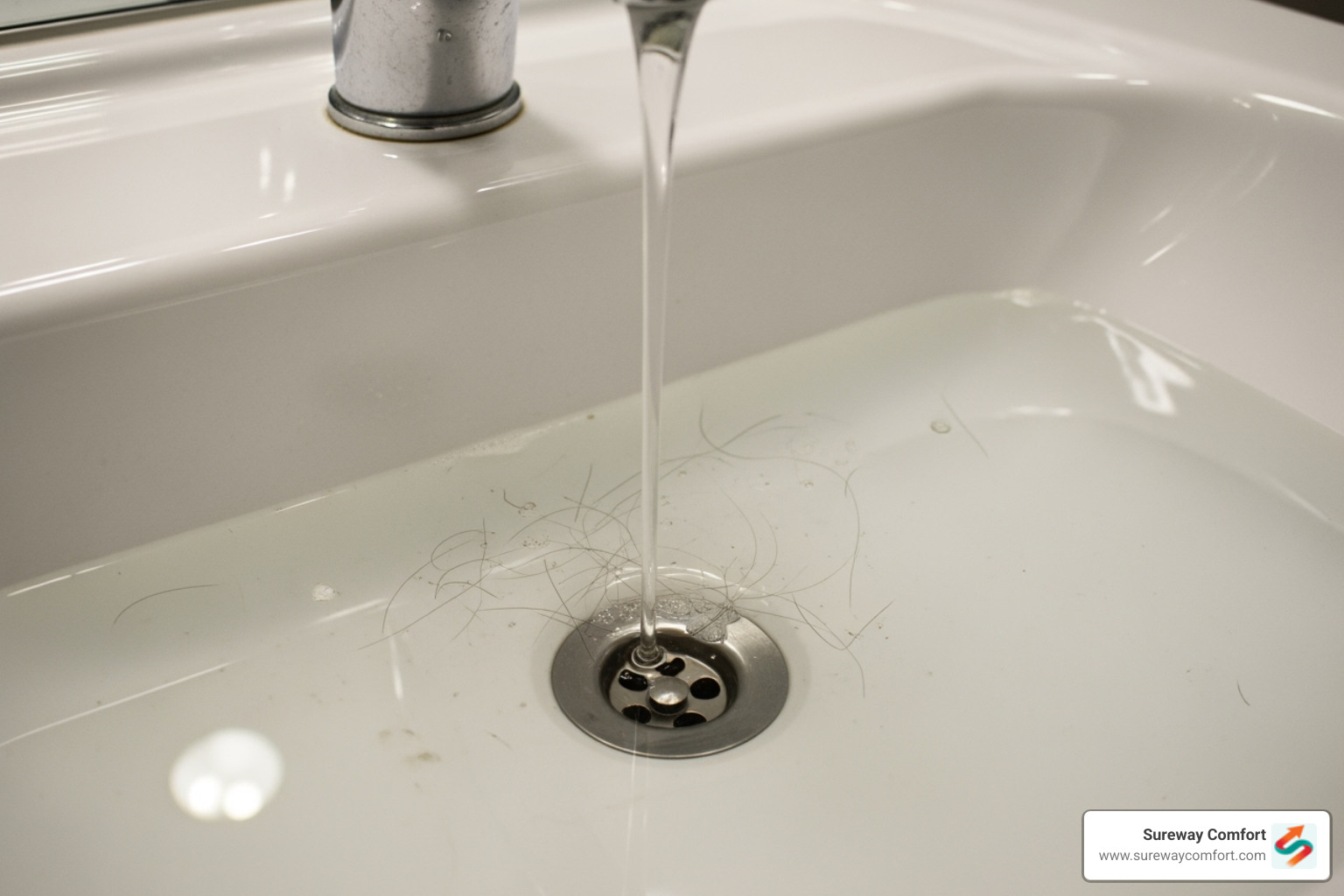



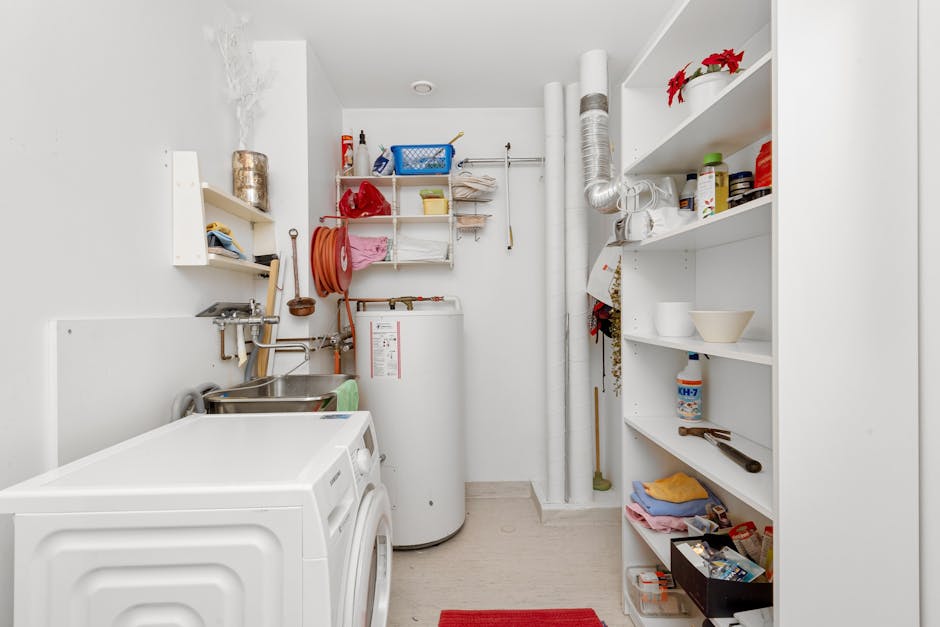




















.avif)



